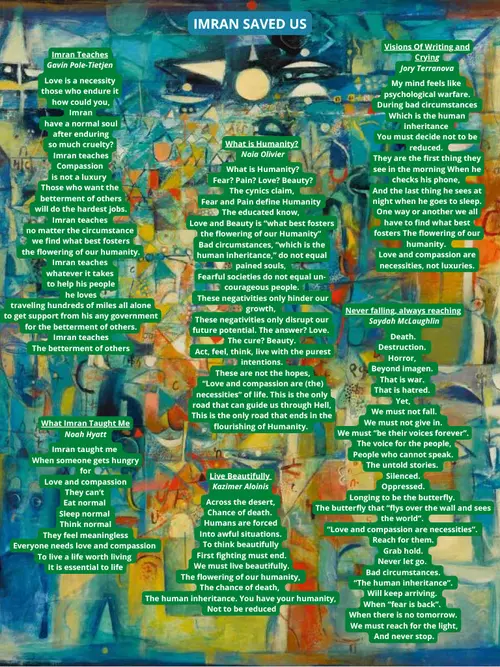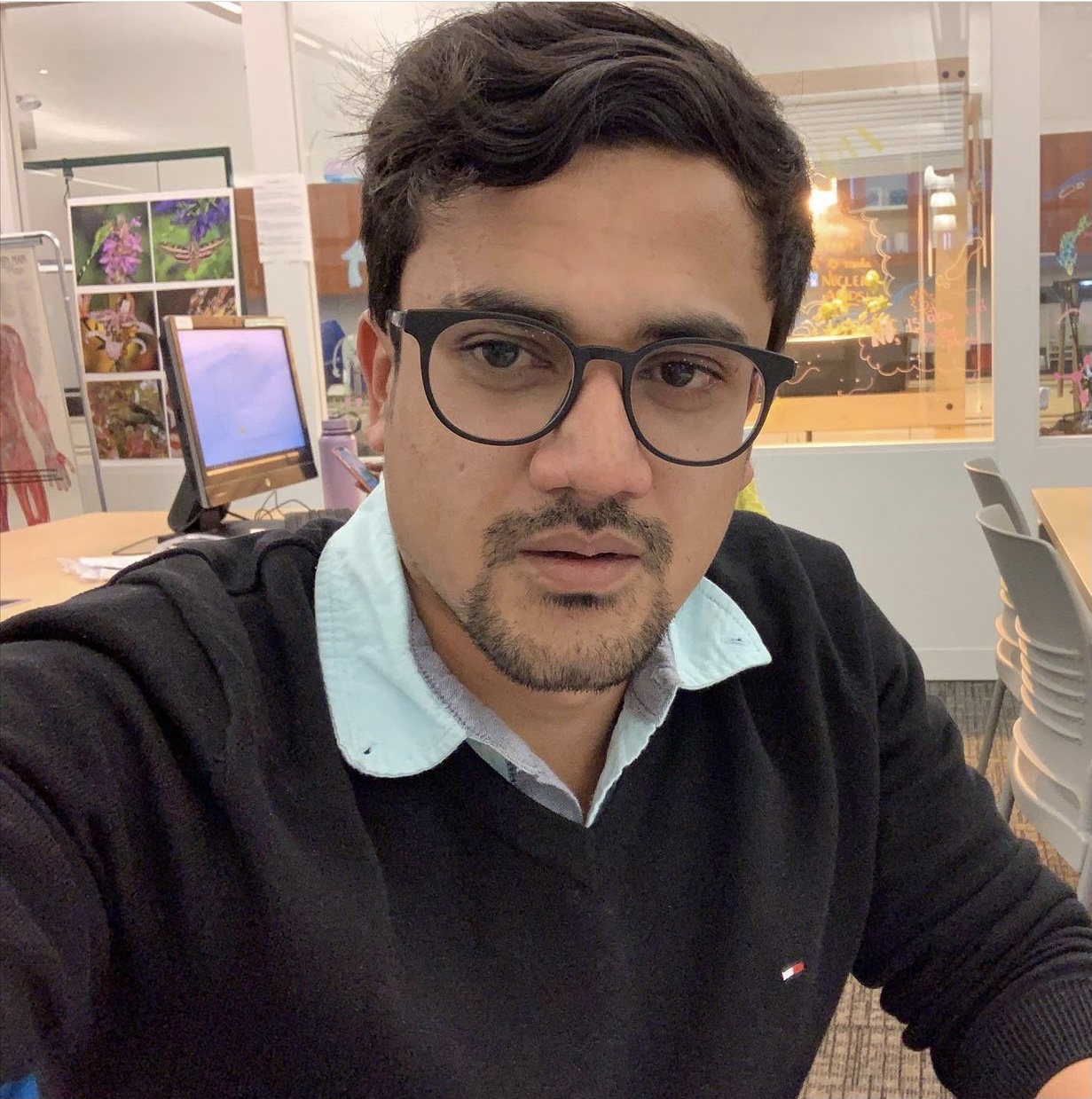This unit was created by Lois MacMillan, a high school History teacher in Grants Pass, OR, as part of the 2021-2022 Pulitzer Center Teacher Fellowship program. It is designed for facilitation across approximately three 60-minute class periods. (Note: The first two lessons do not have to be taught sequentially and each can stand alone. The culminating lesson builds on what was learned in the first three lessons; it may take more than one day to complete.)
For more units created by Pulitzer Center Teacher Fellows in this cohort, click here.
Unit Objectives:
Students will be able to...
- Annotate texts, identifying historical events, superbly written prose, and further questions within the text.
- Analyze and interpret artwork within a collaborative setting.
- Justify the theme of humanity through texts read, annotated, and analyzed.
- Create an original poem and a group mural weaving together favorite prose and artwork from underreported stories and personal connections.
Unit Overview:
Through this unit, students will encounter a refugee from Myanmar who traveled the world and found solace in writing, and an individual who became the recorder of deaths in a community due to civil war in Ethiopia. They will study artwork created by several Rohingya refugees and by Ethiopian artist Wosene Worke Krosof. To process and respond to these stories, they will craft individual poems using phrases from the readings, and will form their poems and the artwork studied into a group mural celebrating humanity. Through this process, students will practice annotating and analyzing texts and interpreting art and prose through “a collective exhibit…from the intimacy of art” (Krosof).
This unit is designed to support students in looking beyond themselves, (re)connecting with other communities, and developing empathy through collaborative analysis.
Humanity is the theme for this unit. Stalin observed, “A single death is a tragedy, a million deaths are a statistic,” so it is essential for students today to go beyond statistics and examine humanity through individuals. The study of history is the study of humanity and the first draft of history is written by journalists. Through the examination and analysis of underreported stories from journalists around the world and the expression of art, prose, and poetry, students may discover a humanity beyond the borders of their community.
Throughout the unit, the theme of humanity will be explored and reinforced through analysis of the following three quotes, alongside the focus texts and artwork:
- “Love and compassion are necessities, not luxuries. Without them, humanity cannot survive.” – Dalai Lama
- “One way or another, we all have to find what best fosters the flowering of our humanity in this contemporary life and dedicate ourselves to that.” – Joseph Campbell
- “During bad circumstances, which is the human inheritance, you must decide not to be reduced. You have your humanity, and you must not allow anything to reduce that. We are obliged to know we are global citizens. Disasters remind us we are world citizens, whether we like it or not.” – Maya Angelou
Performance Task:
Relying on wisdom from Ethiopian artist Wosene Worke Kosrof, students will “create a visible, interactive surface—like visual icons that are accessible to everyone.” Students, as a group, will create a mural or sculpture that forms a “collective exhibit…from the intimacy of art.” Each student will use phrases from the texts explored in this unit, as well as their own completed worksheets from the first two lessons, to write individual poems that the class will weave together to create one big, collective mural.
Three-day unit plan, including warm-ups, classroom activities, texts and artwork, graphic organizers, daily slide presentations, and performance tasks for the unit.
Unit Resources:
| Resources for lesson 1 | Text: “Writing Saved Me” by Imran Mohammad Fazal Hoque for the Pulitzer Center: A personal essay about the journalist’s experience as a Rohingya refugee, and why writing and storytelling matter to him. Artwork: “For Rohingya Survivors, Art Bears Witness” by Patricia Leigh Brown for the New York Times: A news story about art created by people living in Rohingya refugee camps. The photos of artwork and their captions are used in this lesson, and are included in .pdf form in the complete unit plan. |
| Resources for lesson 2 | Text: “You Can’t Even Cry Loudly” by Cara Ana, Nat Castañeda, and Davin Keyton for the Associated Press: A news story about a man who counts and documents the people who have died as a result of the war in Ethiopia’s Tigray region. Artwork: Wosene Worke Kosrof: Website for the Ethiopian painter and sculptor, who creates artwork based on Amharic symbols. A handout and a presentation featuring select paintings are included in the complete unit plan. |
| Resources for all lessons | Throughout this unit, students consider how the following quotes frame the theme of humanity, and how they can support the interpretation of the stories and art they explore. > “Love and compassion are necessities, not luxuries. Without them, humanity cannot survive.” – Dalai Lama > “One way or another, we all have to find what best fosters the flowering of our humanity in this contemporary life and dedicate ourselves to that.” – Joseph Campbell > “During bad circumstances, which is the human inheritance, you must decide not to be reduced. You have your humanity, and you must not allow anything to reduce that. We are obliged to know we are global citizens. Disasters remind us we are world citizens, whether we like it or not.” – Maya Angelou |
Common Core Standards:
CCSS.ELA-LITERACY RI. 11-12.1 Cite strong and thorough textual evidence to support analysis of what the text says explicitly as well as inferences drawn from the text, including determining where the text leaves matters uncertain.
CCSS.ELA-LITERACY RI. 11-12.5 Analyze and evaluate the effectiveness of the structure an author uses in his or her exposition or argument, including whether the structure makes points clear, convincing, and engaging.
CCSS.ELA-LITERACY RI. 11-12.6 Determine an author's point of view or purpose in a text in which the rhetoric is particularly effective, analyzing how style and content contribute to the power, persuasiveness or beauty of the text.
CCSS.ELA-LITERACY RI. 11-12.7 Integrate and evaluate multiple sources of information presented in different media or formats (e.g., visually, quantitatively) as well as in words in order to address a question or solve a problem.
CCSS.ELA-LITERACY.W.11-12.1.C Use words, phrases, and clauses as well as varied syntax to link the major sections of the text, create cohesion, and clarify the relationships between claim(s) and reasons, between reasons and evidence, and between claim(s) and counterclaims.

This unit is assessed through the following formative and summative assessments.
Formative Assessments:
In lessons one and two, students build knowledge through reading, annotating, and analyzing Pulitzer articles. Each day, students will complete:
- An individual worksheet assessing the skills of summarizing and analyzing the text read.
- A group activity worksheet assessing the skills of comparing and distinguishing artwork,
- An exit ticket interpreting how content learned corresponds to quotes on humanity.
All worksheets are available in .pdf and .docx form in the complete unit plan, under the Facilitation Resources tab.
Summative Assessment:
In lesson three, students interpret and create an individual piece that fits into a class-negotiated mural.
Click below to explore example student poems, formatted in a PDF booklet. For an example of a class mural, see above.










